Analyzing Government Strategies to Combat Childhood Obesity in London
VerifiedAdded on 2021/02/20
|12
|4057
|27
Report
AI Summary
This report examines the impact of government strategies in addressing childhood obesity (ages 5-15) in London. It begins with an introduction to obesity as a complex health disorder and its prevalence among children, highlighting the risks of related health problems and the government's focus on strategic plans to reduce it. The report explores the background and rationale for the study, emphasizing the rising concern of childhood obesity in London and the need for intervention programs. It then outlines the aims and objectives, methodology, and ethical considerations of the research. The report further delves into the government's initiatives, such as the National Childhood Measurement Programme (NCMP), school meal plans, and campaigns promoting healthy eating and physical activity, including sugar tax, healthy food programs, and physical education. The discussion covers various factors contributing to obesity, including technological advancements, sedentary habits, and unhealthy food choices. The report also analyzes the impact of the strategies, including the Healthy Child Programme, and the role of the National Institute for Health and Clinical Excellence (NICE), and local authorities in promoting healthy lifestyles and reducing obesity. The study concludes by assessing the effectiveness of these policies and regulations in achieving desired outcomes and maintaining a healthy lifestyle, suggesting that these policies are helpful.
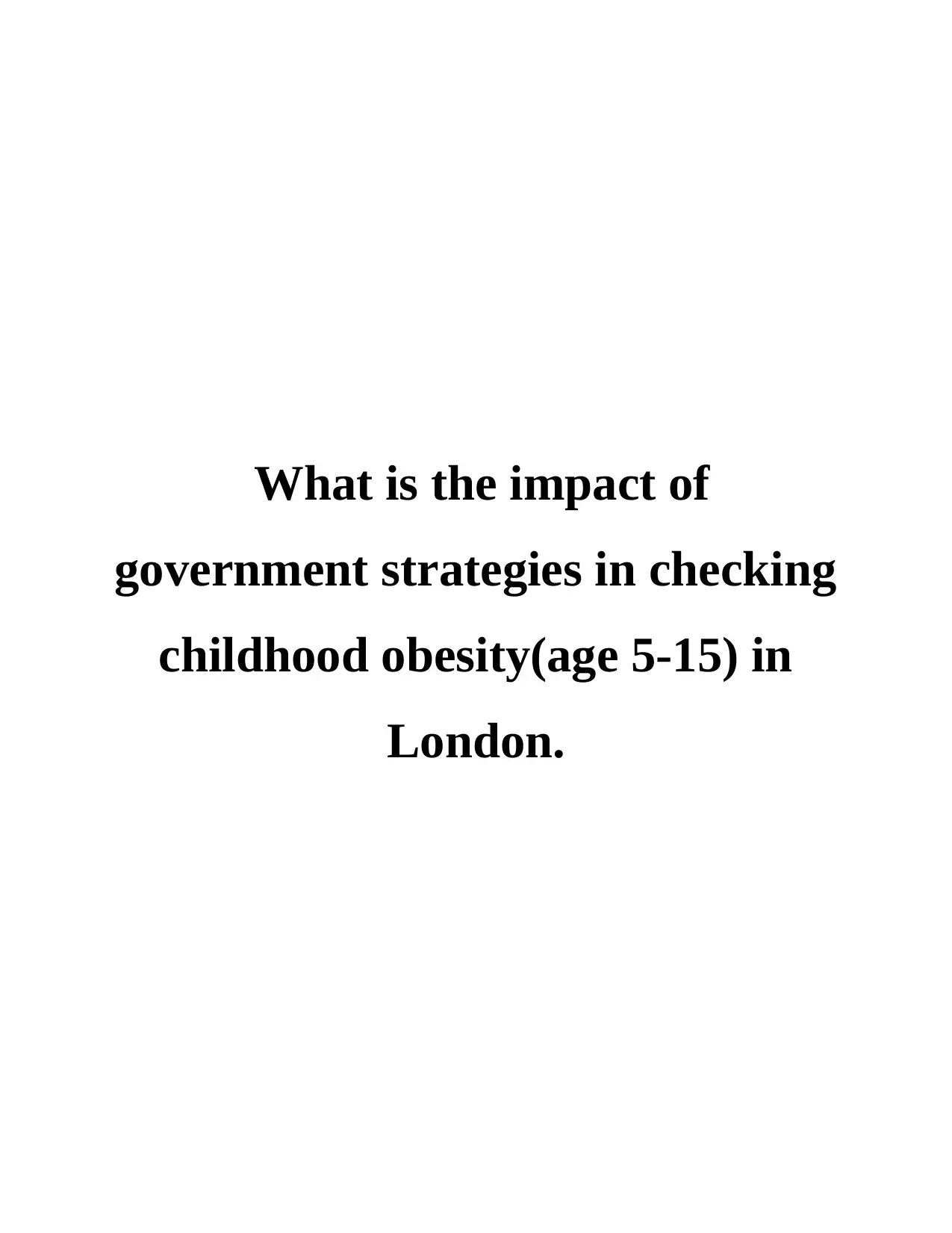
What is the impact of
government strategies in checking
childhood obesity(age 5-15) in
London.
government strategies in checking
childhood obesity(age 5-15) in
London.
Paraphrase This Document
Need a fresh take? Get an instant paraphrase of this document with our AI Paraphraser
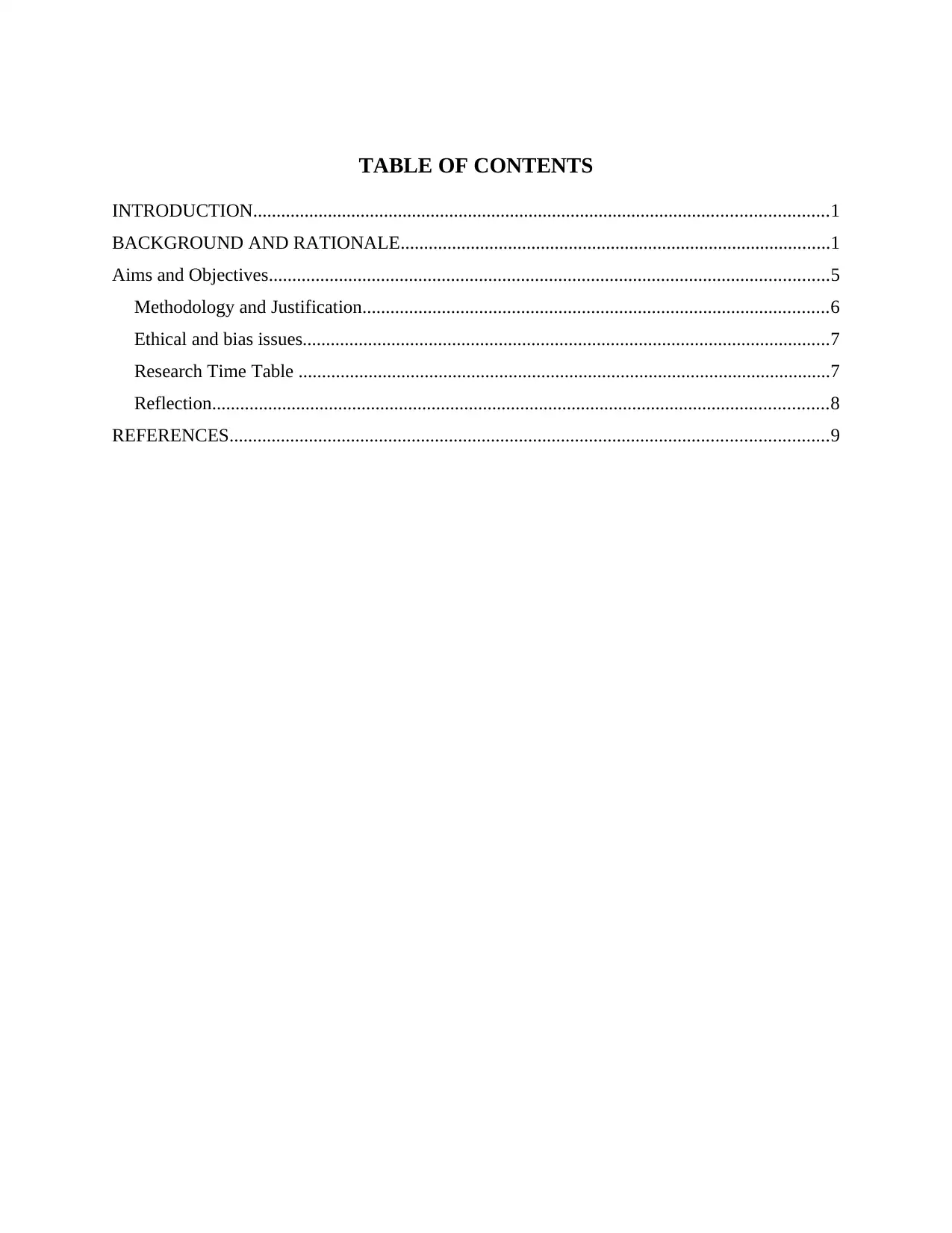
TABLE OF CONTENTS
INTRODUCTION...........................................................................................................................1
BACKGROUND AND RATIONALE............................................................................................1
Aims and Objectives........................................................................................................................5
Methodology and Justification....................................................................................................6
Ethical and bias issues.................................................................................................................7
Research Time Table ..................................................................................................................7
Reflection....................................................................................................................................8
REFERENCES................................................................................................................................9
INTRODUCTION...........................................................................................................................1
BACKGROUND AND RATIONALE............................................................................................1
Aims and Objectives........................................................................................................................5
Methodology and Justification....................................................................................................6
Ethical and bias issues.................................................................................................................7
Research Time Table ..................................................................................................................7
Reflection....................................................................................................................................8
REFERENCES................................................................................................................................9
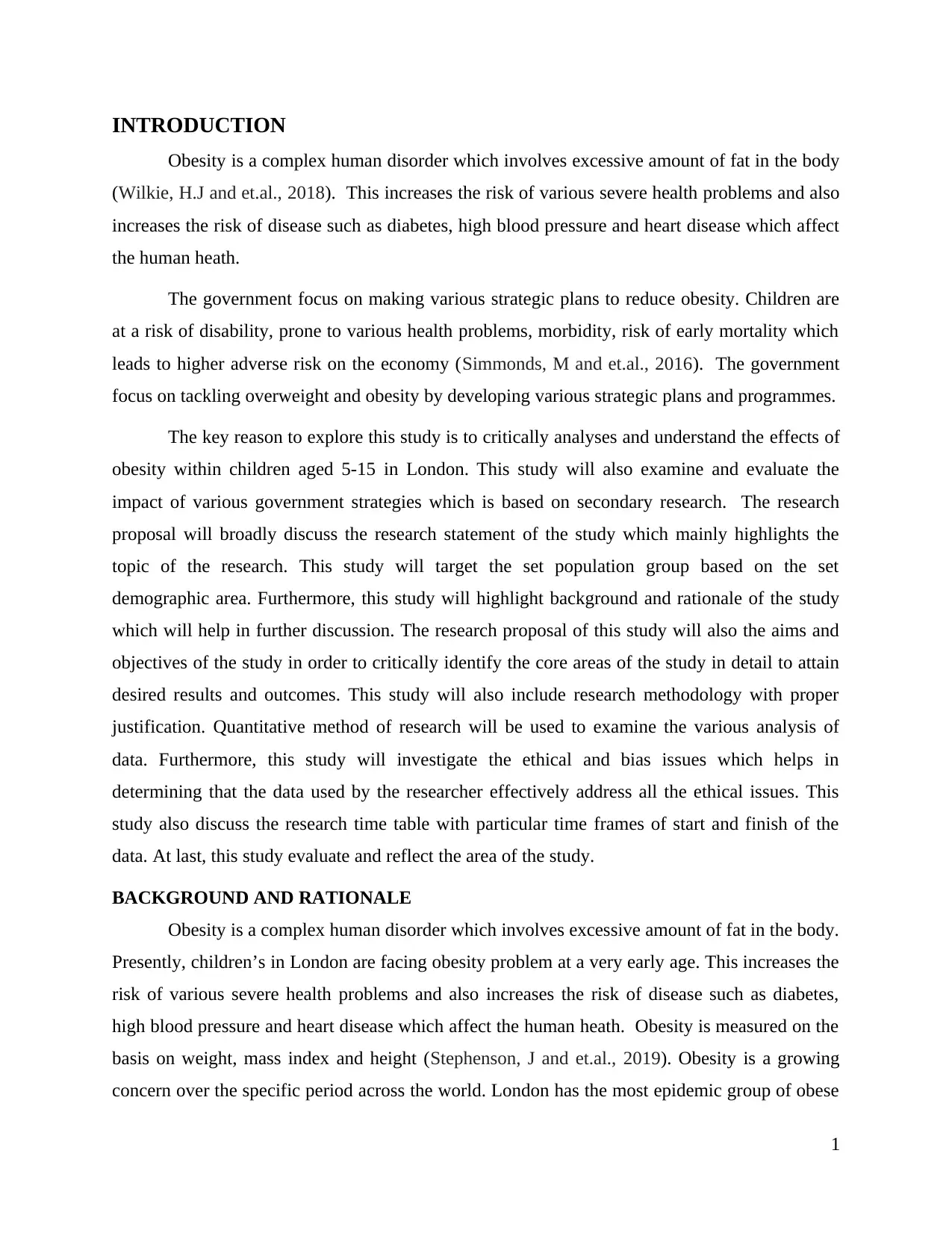
INTRODUCTION
Obesity is a complex human disorder which involves excessive amount of fat in the body
(Wilkie, H.J and et.al., 2018). This increases the risk of various severe health problems and also
increases the risk of disease such as diabetes, high blood pressure and heart disease which affect
the human heath.
The government focus on making various strategic plans to reduce obesity. Children are
at a risk of disability, prone to various health problems, morbidity, risk of early mortality which
leads to higher adverse risk on the economy (Simmonds, M and et.al., 2016). The government
focus on tackling overweight and obesity by developing various strategic plans and programmes.
The key reason to explore this study is to critically analyses and understand the effects of
obesity within children aged 5-15 in London. This study will also examine and evaluate the
impact of various government strategies which is based on secondary research. The research
proposal will broadly discuss the research statement of the study which mainly highlights the
topic of the research. This study will target the set population group based on the set
demographic area. Furthermore, this study will highlight background and rationale of the study
which will help in further discussion. The research proposal of this study will also the aims and
objectives of the study in order to critically identify the core areas of the study in detail to attain
desired results and outcomes. This study will also include research methodology with proper
justification. Quantitative method of research will be used to examine the various analysis of
data. Furthermore, this study will investigate the ethical and bias issues which helps in
determining that the data used by the researcher effectively address all the ethical issues. This
study also discuss the research time table with particular time frames of start and finish of the
data. At last, this study evaluate and reflect the area of the study.
BACKGROUND AND RATIONALE
Obesity is a complex human disorder which involves excessive amount of fat in the body.
Presently, children’s in London are facing obesity problem at a very early age. This increases the
risk of various severe health problems and also increases the risk of disease such as diabetes,
high blood pressure and heart disease which affect the human heath. Obesity is measured on the
basis on weight, mass index and height (Stephenson, J and et.al., 2019). Obesity is a growing
concern over the specific period across the world. London has the most epidemic group of obese
1
Obesity is a complex human disorder which involves excessive amount of fat in the body
(Wilkie, H.J and et.al., 2018). This increases the risk of various severe health problems and also
increases the risk of disease such as diabetes, high blood pressure and heart disease which affect
the human heath.
The government focus on making various strategic plans to reduce obesity. Children are
at a risk of disability, prone to various health problems, morbidity, risk of early mortality which
leads to higher adverse risk on the economy (Simmonds, M and et.al., 2016). The government
focus on tackling overweight and obesity by developing various strategic plans and programmes.
The key reason to explore this study is to critically analyses and understand the effects of
obesity within children aged 5-15 in London. This study will also examine and evaluate the
impact of various government strategies which is based on secondary research. The research
proposal will broadly discuss the research statement of the study which mainly highlights the
topic of the research. This study will target the set population group based on the set
demographic area. Furthermore, this study will highlight background and rationale of the study
which will help in further discussion. The research proposal of this study will also the aims and
objectives of the study in order to critically identify the core areas of the study in detail to attain
desired results and outcomes. This study will also include research methodology with proper
justification. Quantitative method of research will be used to examine the various analysis of
data. Furthermore, this study will investigate the ethical and bias issues which helps in
determining that the data used by the researcher effectively address all the ethical issues. This
study also discuss the research time table with particular time frames of start and finish of the
data. At last, this study evaluate and reflect the area of the study.
BACKGROUND AND RATIONALE
Obesity is a complex human disorder which involves excessive amount of fat in the body.
Presently, children’s in London are facing obesity problem at a very early age. This increases the
risk of various severe health problems and also increases the risk of disease such as diabetes,
high blood pressure and heart disease which affect the human heath. Obesity is measured on the
basis on weight, mass index and height (Stephenson, J and et.al., 2019). Obesity is a growing
concern over the specific period across the world. London has the most epidemic group of obese
1
⊘ This is a preview!⊘
Do you want full access?
Subscribe today to unlock all pages.

Trusted by 1+ million students worldwide
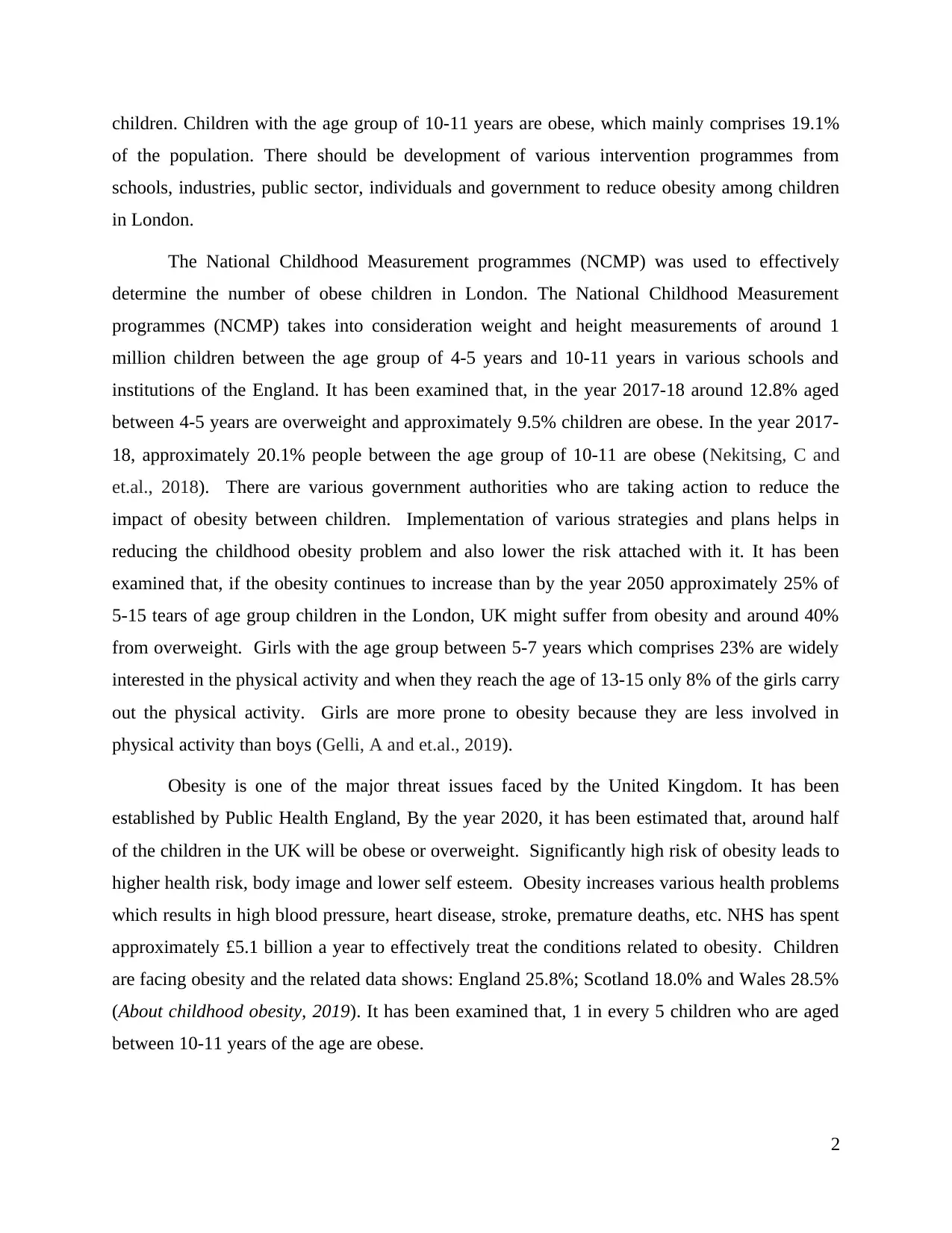
children. Children with the age group of 10-11 years are obese, which mainly comprises 19.1%
of the population. There should be development of various intervention programmes from
schools, industries, public sector, individuals and government to reduce obesity among children
in London.
The National Childhood Measurement programmes (NCMP) was used to effectively
determine the number of obese children in London. The National Childhood Measurement
programmes (NCMP) takes into consideration weight and height measurements of around 1
million children between the age group of 4-5 years and 10-11 years in various schools and
institutions of the England. It has been examined that, in the year 2017-18 around 12.8% aged
between 4-5 years are overweight and approximately 9.5% children are obese. In the year 2017-
18, approximately 20.1% people between the age group of 10-11 are obese (Nekitsing, C and
et.al., 2018). There are various government authorities who are taking action to reduce the
impact of obesity between children. Implementation of various strategies and plans helps in
reducing the childhood obesity problem and also lower the risk attached with it. It has been
examined that, if the obesity continues to increase than by the year 2050 approximately 25% of
5-15 tears of age group children in the London, UK might suffer from obesity and around 40%
from overweight. Girls with the age group between 5-7 years which comprises 23% are widely
interested in the physical activity and when they reach the age of 13-15 only 8% of the girls carry
out the physical activity. Girls are more prone to obesity because they are less involved in
physical activity than boys (Gelli, A and et.al., 2019).
Obesity is one of the major threat issues faced by the United Kingdom. It has been
established by Public Health England, By the year 2020, it has been estimated that, around half
of the children in the UK will be obese or overweight. Significantly high risk of obesity leads to
higher health risk, body image and lower self esteem. Obesity increases various health problems
which results in high blood pressure, heart disease, stroke, premature deaths, etc. NHS has spent
approximately £5.1 billion a year to effectively treat the conditions related to obesity. Children
are facing obesity and the related data shows: England 25.8%; Scotland 18.0% and Wales 28.5%
(About childhood obesity, 2019). It has been examined that, 1 in every 5 children who are aged
between 10-11 years of the age are obese.
2
of the population. There should be development of various intervention programmes from
schools, industries, public sector, individuals and government to reduce obesity among children
in London.
The National Childhood Measurement programmes (NCMP) was used to effectively
determine the number of obese children in London. The National Childhood Measurement
programmes (NCMP) takes into consideration weight and height measurements of around 1
million children between the age group of 4-5 years and 10-11 years in various schools and
institutions of the England. It has been examined that, in the year 2017-18 around 12.8% aged
between 4-5 years are overweight and approximately 9.5% children are obese. In the year 2017-
18, approximately 20.1% people between the age group of 10-11 are obese (Nekitsing, C and
et.al., 2018). There are various government authorities who are taking action to reduce the
impact of obesity between children. Implementation of various strategies and plans helps in
reducing the childhood obesity problem and also lower the risk attached with it. It has been
examined that, if the obesity continues to increase than by the year 2050 approximately 25% of
5-15 tears of age group children in the London, UK might suffer from obesity and around 40%
from overweight. Girls with the age group between 5-7 years which comprises 23% are widely
interested in the physical activity and when they reach the age of 13-15 only 8% of the girls carry
out the physical activity. Girls are more prone to obesity because they are less involved in
physical activity than boys (Gelli, A and et.al., 2019).
Obesity is one of the major threat issues faced by the United Kingdom. It has been
established by Public Health England, By the year 2020, it has been estimated that, around half
of the children in the UK will be obese or overweight. Significantly high risk of obesity leads to
higher health risk, body image and lower self esteem. Obesity increases various health problems
which results in high blood pressure, heart disease, stroke, premature deaths, etc. NHS has spent
approximately £5.1 billion a year to effectively treat the conditions related to obesity. Children
are facing obesity and the related data shows: England 25.8%; Scotland 18.0% and Wales 28.5%
(About childhood obesity, 2019). It has been examined that, 1 in every 5 children who are aged
between 10-11 years of the age are obese.
2
Paraphrase This Document
Need a fresh take? Get an instant paraphrase of this document with our AI Paraphraser
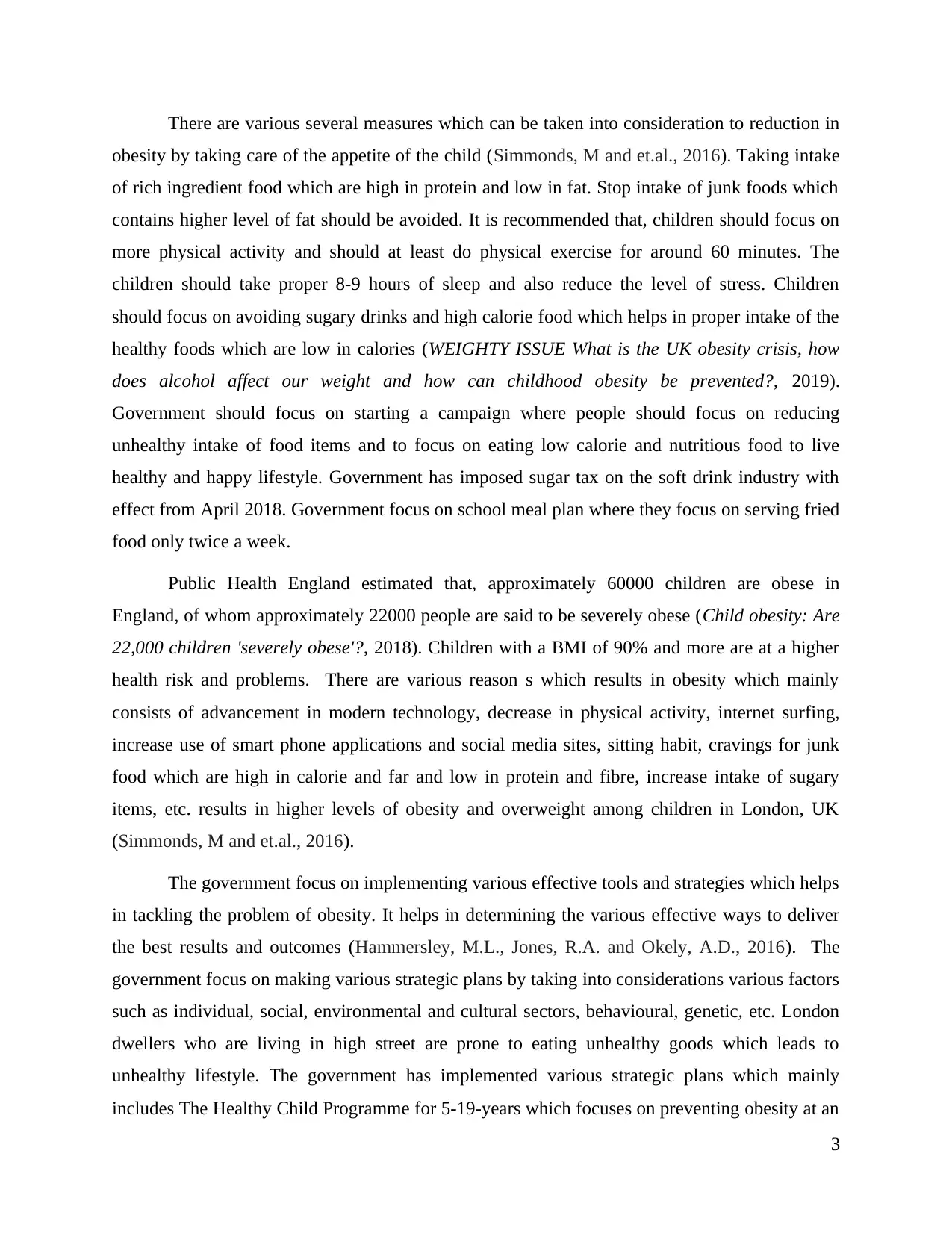
There are various several measures which can be taken into consideration to reduction in
obesity by taking care of the appetite of the child (Simmonds, M and et.al., 2016). Taking intake
of rich ingredient food which are high in protein and low in fat. Stop intake of junk foods which
contains higher level of fat should be avoided. It is recommended that, children should focus on
more physical activity and should at least do physical exercise for around 60 minutes. The
children should take proper 8-9 hours of sleep and also reduce the level of stress. Children
should focus on avoiding sugary drinks and high calorie food which helps in proper intake of the
healthy foods which are low in calories (WEIGHTY ISSUE What is the UK obesity crisis, how
does alcohol affect our weight and how can childhood obesity be prevented?, 2019).
Government should focus on starting a campaign where people should focus on reducing
unhealthy intake of food items and to focus on eating low calorie and nutritious food to live
healthy and happy lifestyle. Government has imposed sugar tax on the soft drink industry with
effect from April 2018. Government focus on school meal plan where they focus on serving fried
food only twice a week.
Public Health England estimated that, approximately 60000 children are obese in
England, of whom approximately 22000 people are said to be severely obese (Child obesity: Are
22,000 children 'severely obese'?, 2018). Children with a BMI of 90% and more are at a higher
health risk and problems. There are various reason s which results in obesity which mainly
consists of advancement in modern technology, decrease in physical activity, internet surfing,
increase use of smart phone applications and social media sites, sitting habit, cravings for junk
food which are high in calorie and far and low in protein and fibre, increase intake of sugary
items, etc. results in higher levels of obesity and overweight among children in London, UK
(Simmonds, M and et.al., 2016).
The government focus on implementing various effective tools and strategies which helps
in tackling the problem of obesity. It helps in determining the various effective ways to deliver
the best results and outcomes (Hammersley, M.L., Jones, R.A. and Okely, A.D., 2016). The
government focus on making various strategic plans by taking into considerations various factors
such as individual, social, environmental and cultural sectors, behavioural, genetic, etc. London
dwellers who are living in high street are prone to eating unhealthy goods which leads to
unhealthy lifestyle. The government has implemented various strategic plans which mainly
includes The Healthy Child Programme for 5-19-years which focuses on preventing obesity at an
3
obesity by taking care of the appetite of the child (Simmonds, M and et.al., 2016). Taking intake
of rich ingredient food which are high in protein and low in fat. Stop intake of junk foods which
contains higher level of fat should be avoided. It is recommended that, children should focus on
more physical activity and should at least do physical exercise for around 60 minutes. The
children should take proper 8-9 hours of sleep and also reduce the level of stress. Children
should focus on avoiding sugary drinks and high calorie food which helps in proper intake of the
healthy foods which are low in calories (WEIGHTY ISSUE What is the UK obesity crisis, how
does alcohol affect our weight and how can childhood obesity be prevented?, 2019).
Government should focus on starting a campaign where people should focus on reducing
unhealthy intake of food items and to focus on eating low calorie and nutritious food to live
healthy and happy lifestyle. Government has imposed sugar tax on the soft drink industry with
effect from April 2018. Government focus on school meal plan where they focus on serving fried
food only twice a week.
Public Health England estimated that, approximately 60000 children are obese in
England, of whom approximately 22000 people are said to be severely obese (Child obesity: Are
22,000 children 'severely obese'?, 2018). Children with a BMI of 90% and more are at a higher
health risk and problems. There are various reason s which results in obesity which mainly
consists of advancement in modern technology, decrease in physical activity, internet surfing,
increase use of smart phone applications and social media sites, sitting habit, cravings for junk
food which are high in calorie and far and low in protein and fibre, increase intake of sugary
items, etc. results in higher levels of obesity and overweight among children in London, UK
(Simmonds, M and et.al., 2016).
The government focus on implementing various effective tools and strategies which helps
in tackling the problem of obesity. It helps in determining the various effective ways to deliver
the best results and outcomes (Hammersley, M.L., Jones, R.A. and Okely, A.D., 2016). The
government focus on making various strategic plans by taking into considerations various factors
such as individual, social, environmental and cultural sectors, behavioural, genetic, etc. London
dwellers who are living in high street are prone to eating unhealthy goods which leads to
unhealthy lifestyle. The government has implemented various strategic plans which mainly
includes The Healthy Child Programme for 5-19-years which focuses on preventing obesity at an
3
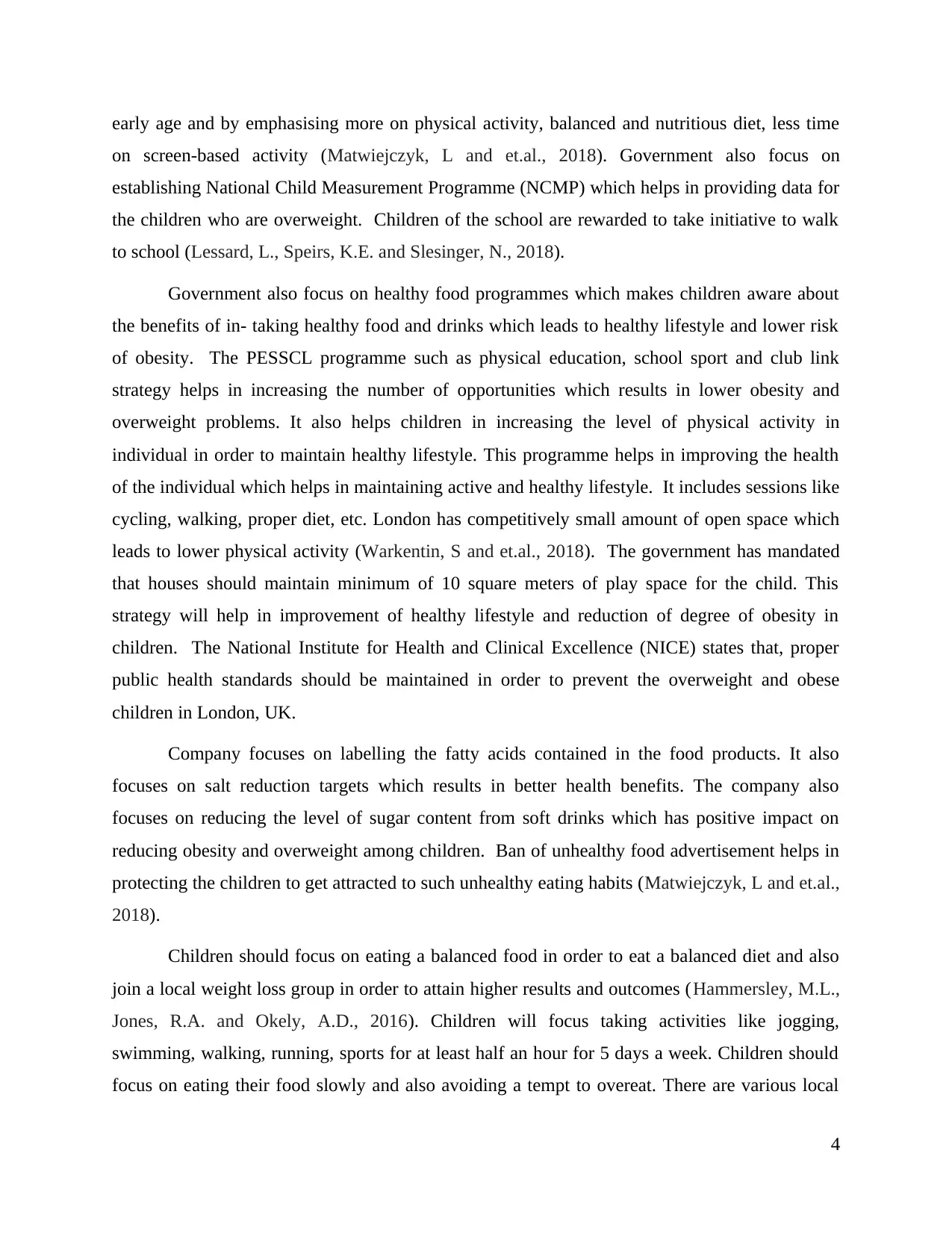
early age and by emphasising more on physical activity, balanced and nutritious diet, less time
on screen-based activity (Matwiejczyk, L and et.al., 2018). Government also focus on
establishing National Child Measurement Programme (NCMP) which helps in providing data for
the children who are overweight. Children of the school are rewarded to take initiative to walk
to school (Lessard, L., Speirs, K.E. and Slesinger, N., 2018).
Government also focus on healthy food programmes which makes children aware about
the benefits of in- taking healthy food and drinks which leads to healthy lifestyle and lower risk
of obesity. The PESSCL programme such as physical education, school sport and club link
strategy helps in increasing the number of opportunities which results in lower obesity and
overweight problems. It also helps children in increasing the level of physical activity in
individual in order to maintain healthy lifestyle. This programme helps in improving the health
of the individual which helps in maintaining active and healthy lifestyle. It includes sessions like
cycling, walking, proper diet, etc. London has competitively small amount of open space which
leads to lower physical activity (Warkentin, S and et.al., 2018). The government has mandated
that houses should maintain minimum of 10 square meters of play space for the child. This
strategy will help in improvement of healthy lifestyle and reduction of degree of obesity in
children. The National Institute for Health and Clinical Excellence (NICE) states that, proper
public health standards should be maintained in order to prevent the overweight and obese
children in London, UK.
Company focuses on labelling the fatty acids contained in the food products. It also
focuses on salt reduction targets which results in better health benefits. The company also
focuses on reducing the level of sugar content from soft drinks which has positive impact on
reducing obesity and overweight among children. Ban of unhealthy food advertisement helps in
protecting the children to get attracted to such unhealthy eating habits (Matwiejczyk, L and et.al.,
2018).
Children should focus on eating a balanced food in order to eat a balanced diet and also
join a local weight loss group in order to attain higher results and outcomes (Hammersley, M.L.,
Jones, R.A. and Okely, A.D., 2016). Children will focus taking activities like jogging,
swimming, walking, running, sports for at least half an hour for 5 days a week. Children should
focus on eating their food slowly and also avoiding a tempt to overeat. There are various local
4
on screen-based activity (Matwiejczyk, L and et.al., 2018). Government also focus on
establishing National Child Measurement Programme (NCMP) which helps in providing data for
the children who are overweight. Children of the school are rewarded to take initiative to walk
to school (Lessard, L., Speirs, K.E. and Slesinger, N., 2018).
Government also focus on healthy food programmes which makes children aware about
the benefits of in- taking healthy food and drinks which leads to healthy lifestyle and lower risk
of obesity. The PESSCL programme such as physical education, school sport and club link
strategy helps in increasing the number of opportunities which results in lower obesity and
overweight problems. It also helps children in increasing the level of physical activity in
individual in order to maintain healthy lifestyle. This programme helps in improving the health
of the individual which helps in maintaining active and healthy lifestyle. It includes sessions like
cycling, walking, proper diet, etc. London has competitively small amount of open space which
leads to lower physical activity (Warkentin, S and et.al., 2018). The government has mandated
that houses should maintain minimum of 10 square meters of play space for the child. This
strategy will help in improvement of healthy lifestyle and reduction of degree of obesity in
children. The National Institute for Health and Clinical Excellence (NICE) states that, proper
public health standards should be maintained in order to prevent the overweight and obese
children in London, UK.
Company focuses on labelling the fatty acids contained in the food products. It also
focuses on salt reduction targets which results in better health benefits. The company also
focuses on reducing the level of sugar content from soft drinks which has positive impact on
reducing obesity and overweight among children. Ban of unhealthy food advertisement helps in
protecting the children to get attracted to such unhealthy eating habits (Matwiejczyk, L and et.al.,
2018).
Children should focus on eating a balanced food in order to eat a balanced diet and also
join a local weight loss group in order to attain higher results and outcomes (Hammersley, M.L.,
Jones, R.A. and Okely, A.D., 2016). Children will focus taking activities like jogging,
swimming, walking, running, sports for at least half an hour for 5 days a week. Children should
focus on eating their food slowly and also avoiding a tempt to overeat. There are various local
4
⊘ This is a preview!⊘
Do you want full access?
Subscribe today to unlock all pages.

Trusted by 1+ million students worldwide
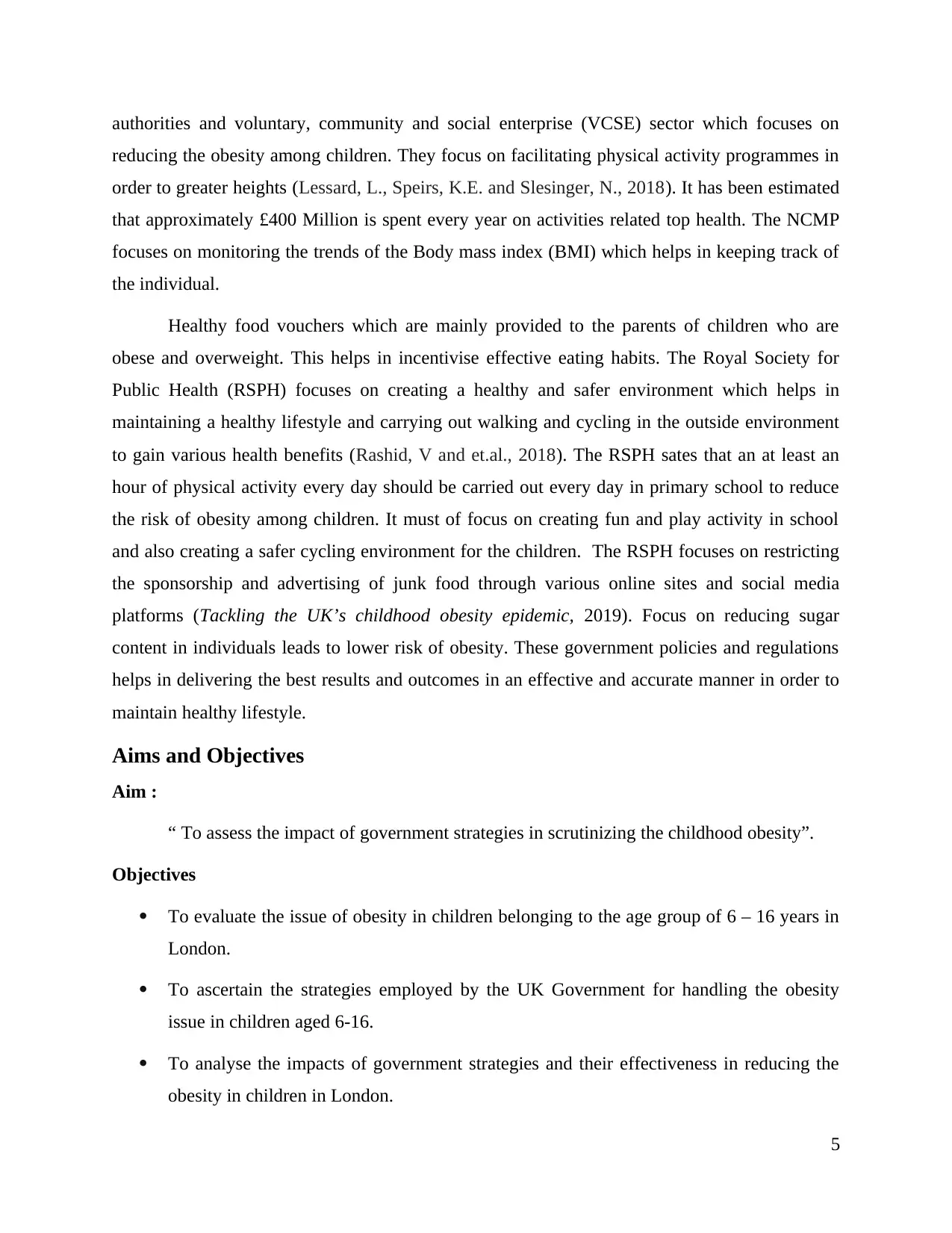
authorities and voluntary, community and social enterprise (VCSE) sector which focuses on
reducing the obesity among children. They focus on facilitating physical activity programmes in
order to greater heights (Lessard, L., Speirs, K.E. and Slesinger, N., 2018). It has been estimated
that approximately £400 Million is spent every year on activities related top health. The NCMP
focuses on monitoring the trends of the Body mass index (BMI) which helps in keeping track of
the individual.
Healthy food vouchers which are mainly provided to the parents of children who are
obese and overweight. This helps in incentivise effective eating habits. The Royal Society for
Public Health (RSPH) focuses on creating a healthy and safer environment which helps in
maintaining a healthy lifestyle and carrying out walking and cycling in the outside environment
to gain various health benefits (Rashid, V and et.al., 2018). The RSPH sates that an at least an
hour of physical activity every day should be carried out every day in primary school to reduce
the risk of obesity among children. It must of focus on creating fun and play activity in school
and also creating a safer cycling environment for the children. The RSPH focuses on restricting
the sponsorship and advertising of junk food through various online sites and social media
platforms (Tackling the UK’s childhood obesity epidemic, 2019). Focus on reducing sugar
content in individuals leads to lower risk of obesity. These government policies and regulations
helps in delivering the best results and outcomes in an effective and accurate manner in order to
maintain healthy lifestyle.
Aims and Objectives
Aim :
“ To assess the impact of government strategies in scrutinizing the childhood obesity”.
Objectives
To evaluate the issue of obesity in children belonging to the age group of 6 – 16 years in
London.
To ascertain the strategies employed by the UK Government for handling the obesity
issue in children aged 6-16.
To analyse the impacts of government strategies and their effectiveness in reducing the
obesity in children in London.
5
reducing the obesity among children. They focus on facilitating physical activity programmes in
order to greater heights (Lessard, L., Speirs, K.E. and Slesinger, N., 2018). It has been estimated
that approximately £400 Million is spent every year on activities related top health. The NCMP
focuses on monitoring the trends of the Body mass index (BMI) which helps in keeping track of
the individual.
Healthy food vouchers which are mainly provided to the parents of children who are
obese and overweight. This helps in incentivise effective eating habits. The Royal Society for
Public Health (RSPH) focuses on creating a healthy and safer environment which helps in
maintaining a healthy lifestyle and carrying out walking and cycling in the outside environment
to gain various health benefits (Rashid, V and et.al., 2018). The RSPH sates that an at least an
hour of physical activity every day should be carried out every day in primary school to reduce
the risk of obesity among children. It must of focus on creating fun and play activity in school
and also creating a safer cycling environment for the children. The RSPH focuses on restricting
the sponsorship and advertising of junk food through various online sites and social media
platforms (Tackling the UK’s childhood obesity epidemic, 2019). Focus on reducing sugar
content in individuals leads to lower risk of obesity. These government policies and regulations
helps in delivering the best results and outcomes in an effective and accurate manner in order to
maintain healthy lifestyle.
Aims and Objectives
Aim :
“ To assess the impact of government strategies in scrutinizing the childhood obesity”.
Objectives
To evaluate the issue of obesity in children belonging to the age group of 6 – 16 years in
London.
To ascertain the strategies employed by the UK Government for handling the obesity
issue in children aged 6-16.
To analyse the impacts of government strategies and their effectiveness in reducing the
obesity in children in London.
5
Paraphrase This Document
Need a fresh take? Get an instant paraphrase of this document with our AI Paraphraser
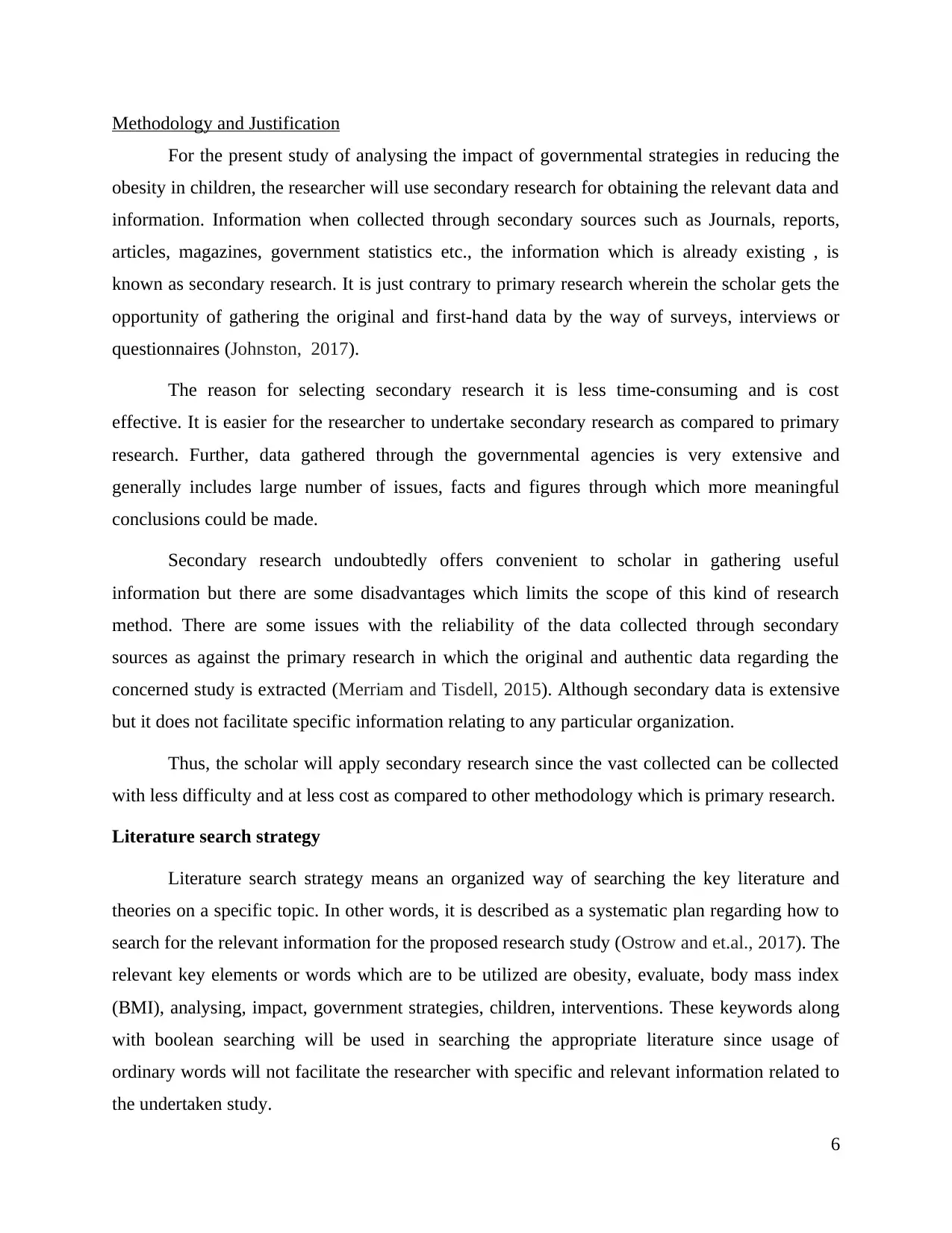
Methodology and Justification
For the present study of analysing the impact of governmental strategies in reducing the
obesity in children, the researcher will use secondary research for obtaining the relevant data and
information. Information when collected through secondary sources such as Journals, reports,
articles, magazines, government statistics etc., the information which is already existing , is
known as secondary research. It is just contrary to primary research wherein the scholar gets the
opportunity of gathering the original and first-hand data by the way of surveys, interviews or
questionnaires (Johnston, 2017).
The reason for selecting secondary research it is less time-consuming and is cost
effective. It is easier for the researcher to undertake secondary research as compared to primary
research. Further, data gathered through the governmental agencies is very extensive and
generally includes large number of issues, facts and figures through which more meaningful
conclusions could be made.
Secondary research undoubtedly offers convenient to scholar in gathering useful
information but there are some disadvantages which limits the scope of this kind of research
method. There are some issues with the reliability of the data collected through secondary
sources as against the primary research in which the original and authentic data regarding the
concerned study is extracted (Merriam and Tisdell, 2015). Although secondary data is extensive
but it does not facilitate specific information relating to any particular organization.
Thus, the scholar will apply secondary research since the vast collected can be collected
with less difficulty and at less cost as compared to other methodology which is primary research.
Literature search strategy
Literature search strategy means an organized way of searching the key literature and
theories on a specific topic. In other words, it is described as a systematic plan regarding how to
search for the relevant information for the proposed research study (Ostrow and et.al., 2017). The
relevant key elements or words which are to be utilized are obesity, evaluate, body mass index
(BMI), analysing, impact, government strategies, children, interventions. These keywords along
with boolean searching will be used in searching the appropriate literature since usage of
ordinary words will not facilitate the researcher with specific and relevant information related to
the undertaken study.
6
For the present study of analysing the impact of governmental strategies in reducing the
obesity in children, the researcher will use secondary research for obtaining the relevant data and
information. Information when collected through secondary sources such as Journals, reports,
articles, magazines, government statistics etc., the information which is already existing , is
known as secondary research. It is just contrary to primary research wherein the scholar gets the
opportunity of gathering the original and first-hand data by the way of surveys, interviews or
questionnaires (Johnston, 2017).
The reason for selecting secondary research it is less time-consuming and is cost
effective. It is easier for the researcher to undertake secondary research as compared to primary
research. Further, data gathered through the governmental agencies is very extensive and
generally includes large number of issues, facts and figures through which more meaningful
conclusions could be made.
Secondary research undoubtedly offers convenient to scholar in gathering useful
information but there are some disadvantages which limits the scope of this kind of research
method. There are some issues with the reliability of the data collected through secondary
sources as against the primary research in which the original and authentic data regarding the
concerned study is extracted (Merriam and Tisdell, 2015). Although secondary data is extensive
but it does not facilitate specific information relating to any particular organization.
Thus, the scholar will apply secondary research since the vast collected can be collected
with less difficulty and at less cost as compared to other methodology which is primary research.
Literature search strategy
Literature search strategy means an organized way of searching the key literature and
theories on a specific topic. In other words, it is described as a systematic plan regarding how to
search for the relevant information for the proposed research study (Ostrow and et.al., 2017). The
relevant key elements or words which are to be utilized are obesity, evaluate, body mass index
(BMI), analysing, impact, government strategies, children, interventions. These keywords along
with boolean searching will be used in searching the appropriate literature since usage of
ordinary words will not facilitate the researcher with specific and relevant information related to
the undertaken study.
6
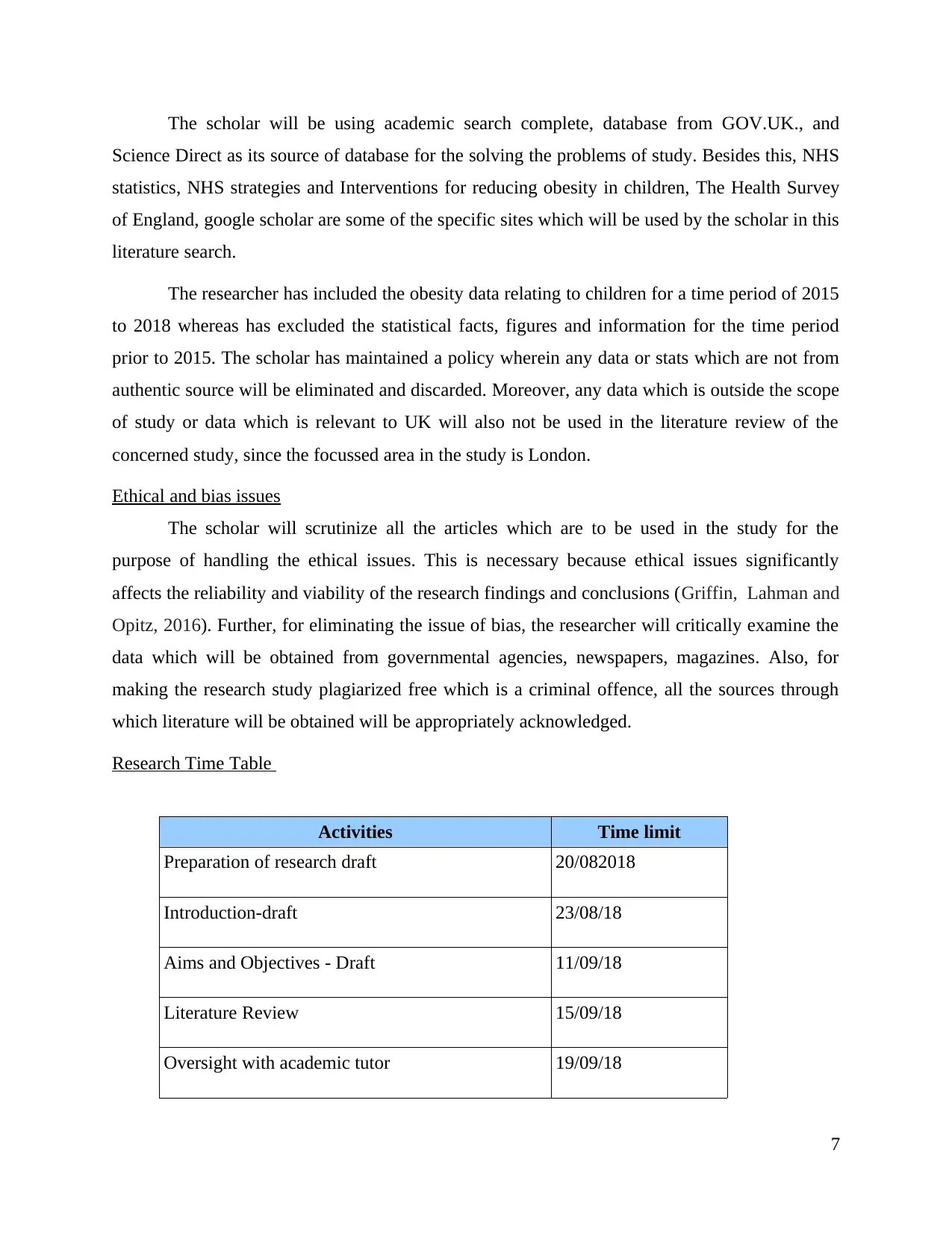
The scholar will be using academic search complete, database from GOV.UK., and
Science Direct as its source of database for the solving the problems of study. Besides this, NHS
statistics, NHS strategies and Interventions for reducing obesity in children, The Health Survey
of England, google scholar are some of the specific sites which will be used by the scholar in this
literature search.
The researcher has included the obesity data relating to children for a time period of 2015
to 2018 whereas has excluded the statistical facts, figures and information for the time period
prior to 2015. The scholar has maintained a policy wherein any data or stats which are not from
authentic source will be eliminated and discarded. Moreover, any data which is outside the scope
of study or data which is relevant to UK will also not be used in the literature review of the
concerned study, since the focussed area in the study is London.
Ethical and bias issues
The scholar will scrutinize all the articles which are to be used in the study for the
purpose of handling the ethical issues. This is necessary because ethical issues significantly
affects the reliability and viability of the research findings and conclusions (Griffin, Lahman and
Opitz, 2016). Further, for eliminating the issue of bias, the researcher will critically examine the
data which will be obtained from governmental agencies, newspapers, magazines. Also, for
making the research study plagiarized free which is a criminal offence, all the sources through
which literature will be obtained will be appropriately acknowledged.
Research Time Table
Activities Time limit
Preparation of research draft 20/082018
Introduction-draft 23/08/18
Aims and Objectives - Draft 11/09/18
Literature Review 15/09/18
Oversight with academic tutor 19/09/18
7
Science Direct as its source of database for the solving the problems of study. Besides this, NHS
statistics, NHS strategies and Interventions for reducing obesity in children, The Health Survey
of England, google scholar are some of the specific sites which will be used by the scholar in this
literature search.
The researcher has included the obesity data relating to children for a time period of 2015
to 2018 whereas has excluded the statistical facts, figures and information for the time period
prior to 2015. The scholar has maintained a policy wherein any data or stats which are not from
authentic source will be eliminated and discarded. Moreover, any data which is outside the scope
of study or data which is relevant to UK will also not be used in the literature review of the
concerned study, since the focussed area in the study is London.
Ethical and bias issues
The scholar will scrutinize all the articles which are to be used in the study for the
purpose of handling the ethical issues. This is necessary because ethical issues significantly
affects the reliability and viability of the research findings and conclusions (Griffin, Lahman and
Opitz, 2016). Further, for eliminating the issue of bias, the researcher will critically examine the
data which will be obtained from governmental agencies, newspapers, magazines. Also, for
making the research study plagiarized free which is a criminal offence, all the sources through
which literature will be obtained will be appropriately acknowledged.
Research Time Table
Activities Time limit
Preparation of research draft 20/082018
Introduction-draft 23/08/18
Aims and Objectives - Draft 11/09/18
Literature Review 15/09/18
Oversight with academic tutor 19/09/18
7
⊘ This is a preview!⊘
Do you want full access?
Subscribe today to unlock all pages.

Trusted by 1+ million students worldwide
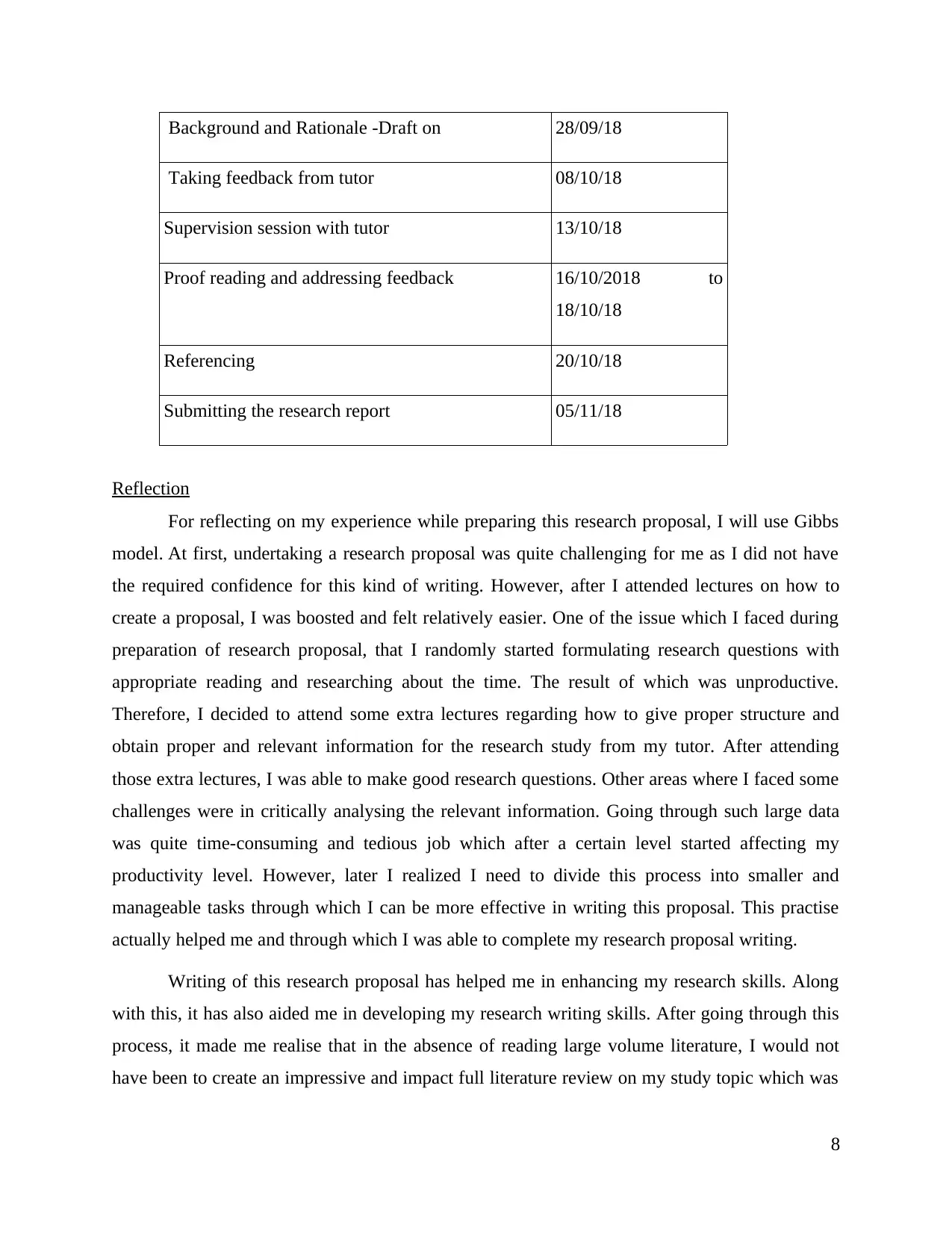
Background and Rationale -Draft on 28/09/18
Taking feedback from tutor 08/10/18
Supervision session with tutor 13/10/18
Proof reading and addressing feedback 16/10/2018 to
18/10/18
Referencing 20/10/18
Submitting the research report 05/11/18
Reflection
For reflecting on my experience while preparing this research proposal, I will use Gibbs
model. At first, undertaking a research proposal was quite challenging for me as I did not have
the required confidence for this kind of writing. However, after I attended lectures on how to
create a proposal, I was boosted and felt relatively easier. One of the issue which I faced during
preparation of research proposal, that I randomly started formulating research questions with
appropriate reading and researching about the time. The result of which was unproductive.
Therefore, I decided to attend some extra lectures regarding how to give proper structure and
obtain proper and relevant information for the research study from my tutor. After attending
those extra lectures, I was able to make good research questions. Other areas where I faced some
challenges were in critically analysing the relevant information. Going through such large data
was quite time-consuming and tedious job which after a certain level started affecting my
productivity level. However, later I realized I need to divide this process into smaller and
manageable tasks through which I can be more effective in writing this proposal. This practise
actually helped me and through which I was able to complete my research proposal writing.
Writing of this research proposal has helped me in enhancing my research skills. Along
with this, it has also aided me in developing my research writing skills. After going through this
process, it made me realise that in the absence of reading large volume literature, I would not
have been to create an impressive and impact full literature review on my study topic which was
8
Taking feedback from tutor 08/10/18
Supervision session with tutor 13/10/18
Proof reading and addressing feedback 16/10/2018 to
18/10/18
Referencing 20/10/18
Submitting the research report 05/11/18
Reflection
For reflecting on my experience while preparing this research proposal, I will use Gibbs
model. At first, undertaking a research proposal was quite challenging for me as I did not have
the required confidence for this kind of writing. However, after I attended lectures on how to
create a proposal, I was boosted and felt relatively easier. One of the issue which I faced during
preparation of research proposal, that I randomly started formulating research questions with
appropriate reading and researching about the time. The result of which was unproductive.
Therefore, I decided to attend some extra lectures regarding how to give proper structure and
obtain proper and relevant information for the research study from my tutor. After attending
those extra lectures, I was able to make good research questions. Other areas where I faced some
challenges were in critically analysing the relevant information. Going through such large data
was quite time-consuming and tedious job which after a certain level started affecting my
productivity level. However, later I realized I need to divide this process into smaller and
manageable tasks through which I can be more effective in writing this proposal. This practise
actually helped me and through which I was able to complete my research proposal writing.
Writing of this research proposal has helped me in enhancing my research skills. Along
with this, it has also aided me in developing my research writing skills. After going through this
process, it made me realise that in the absence of reading large volume literature, I would not
have been to create an impressive and impact full literature review on my study topic which was
8
Paraphrase This Document
Need a fresh take? Get an instant paraphrase of this document with our AI Paraphraser

assessing the impact of governmental strategies in handling the obesity issue in children ranging
from 6 -16 years group age.
9
from 6 -16 years group age.
9
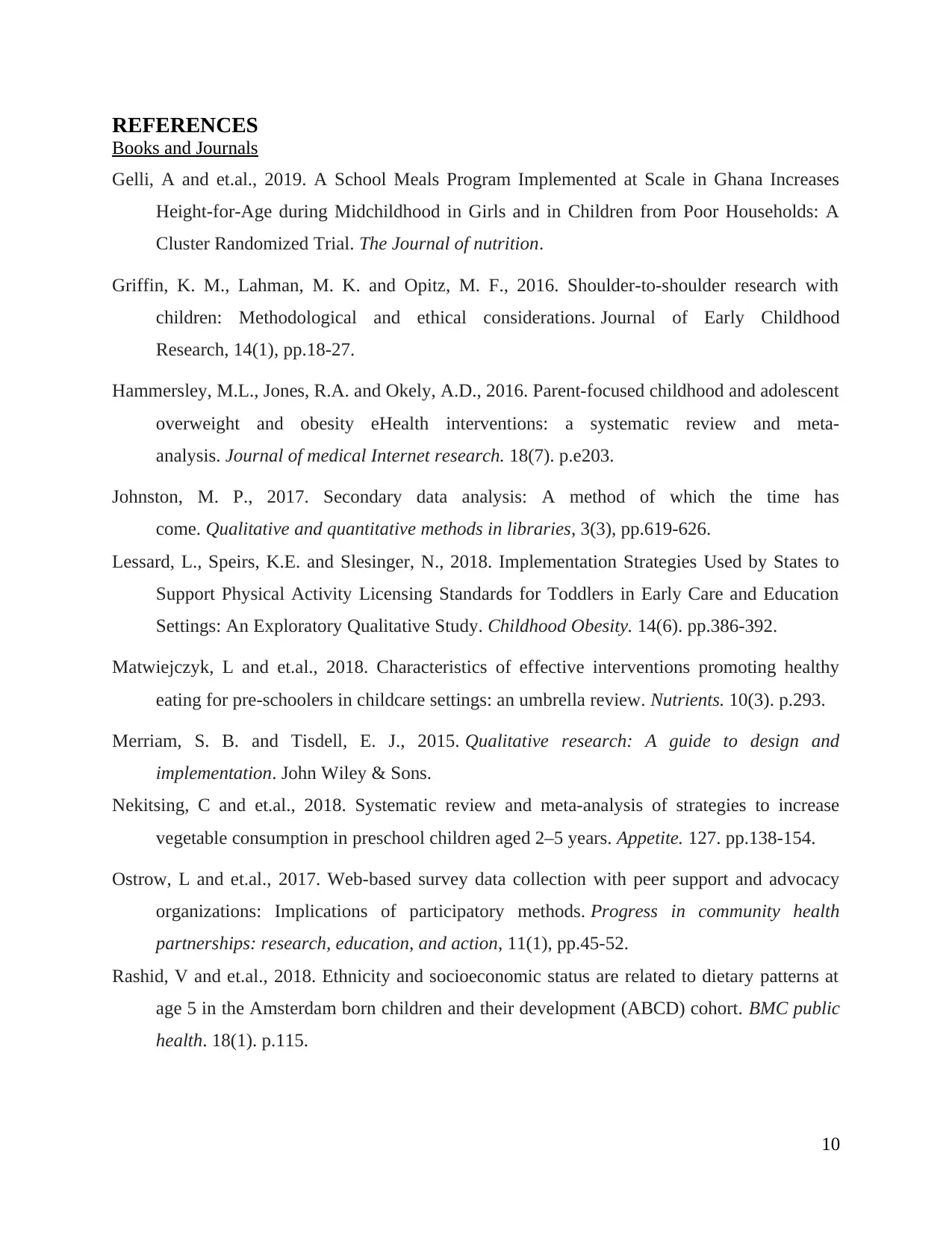
REFERENCES
Books and Journals
Gelli, A and et.al., 2019. A School Meals Program Implemented at Scale in Ghana Increases
Height-for-Age during Midchildhood in Girls and in Children from Poor Households: A
Cluster Randomized Trial. The Journal of nutrition.
Griffin, K. M., Lahman, M. K. and Opitz, M. F., 2016. Shoulder-to-shoulder research with
children: Methodological and ethical considerations. Journal of Early Childhood
Research, 14(1), pp.18-27.
Hammersley, M.L., Jones, R.A. and Okely, A.D., 2016. Parent-focused childhood and adolescent
overweight and obesity eHealth interventions: a systematic review and meta-
analysis. Journal of medical Internet research. 18(7). p.e203.
Johnston, M. P., 2017. Secondary data analysis: A method of which the time has
come. Qualitative and quantitative methods in libraries, 3(3), pp.619-626.
Lessard, L., Speirs, K.E. and Slesinger, N., 2018. Implementation Strategies Used by States to
Support Physical Activity Licensing Standards for Toddlers in Early Care and Education
Settings: An Exploratory Qualitative Study. Childhood Obesity. 14(6). pp.386-392.
Matwiejczyk, L and et.al., 2018. Characteristics of effective interventions promoting healthy
eating for pre-schoolers in childcare settings: an umbrella review. Nutrients. 10(3). p.293.
Merriam, S. B. and Tisdell, E. J., 2015. Qualitative research: A guide to design and
implementation. John Wiley & Sons.
Nekitsing, C and et.al., 2018. Systematic review and meta-analysis of strategies to increase
vegetable consumption in preschool children aged 2–5 years. Appetite. 127. pp.138-154.
Ostrow, L and et.al., 2017. Web-based survey data collection with peer support and advocacy
organizations: Implications of participatory methods. Progress in community health
partnerships: research, education, and action, 11(1), pp.45-52.
Rashid, V and et.al., 2018. Ethnicity and socioeconomic status are related to dietary patterns at
age 5 in the Amsterdam born children and their development (ABCD) cohort. BMC public
health. 18(1). p.115.
10
Books and Journals
Gelli, A and et.al., 2019. A School Meals Program Implemented at Scale in Ghana Increases
Height-for-Age during Midchildhood in Girls and in Children from Poor Households: A
Cluster Randomized Trial. The Journal of nutrition.
Griffin, K. M., Lahman, M. K. and Opitz, M. F., 2016. Shoulder-to-shoulder research with
children: Methodological and ethical considerations. Journal of Early Childhood
Research, 14(1), pp.18-27.
Hammersley, M.L., Jones, R.A. and Okely, A.D., 2016. Parent-focused childhood and adolescent
overweight and obesity eHealth interventions: a systematic review and meta-
analysis. Journal of medical Internet research. 18(7). p.e203.
Johnston, M. P., 2017. Secondary data analysis: A method of which the time has
come. Qualitative and quantitative methods in libraries, 3(3), pp.619-626.
Lessard, L., Speirs, K.E. and Slesinger, N., 2018. Implementation Strategies Used by States to
Support Physical Activity Licensing Standards for Toddlers in Early Care and Education
Settings: An Exploratory Qualitative Study. Childhood Obesity. 14(6). pp.386-392.
Matwiejczyk, L and et.al., 2018. Characteristics of effective interventions promoting healthy
eating for pre-schoolers in childcare settings: an umbrella review. Nutrients. 10(3). p.293.
Merriam, S. B. and Tisdell, E. J., 2015. Qualitative research: A guide to design and
implementation. John Wiley & Sons.
Nekitsing, C and et.al., 2018. Systematic review and meta-analysis of strategies to increase
vegetable consumption in preschool children aged 2–5 years. Appetite. 127. pp.138-154.
Ostrow, L and et.al., 2017. Web-based survey data collection with peer support and advocacy
organizations: Implications of participatory methods. Progress in community health
partnerships: research, education, and action, 11(1), pp.45-52.
Rashid, V and et.al., 2018. Ethnicity and socioeconomic status are related to dietary patterns at
age 5 in the Amsterdam born children and their development (ABCD) cohort. BMC public
health. 18(1). p.115.
10
⊘ This is a preview!⊘
Do you want full access?
Subscribe today to unlock all pages.

Trusted by 1+ million students worldwide
1 out of 12
Related Documents
Your All-in-One AI-Powered Toolkit for Academic Success.
+13062052269
info@desklib.com
Available 24*7 on WhatsApp / Email
![[object Object]](/_next/static/media/star-bottom.7253800d.svg)
Unlock your academic potential
Copyright © 2020–2025 A2Z Services. All Rights Reserved. Developed and managed by ZUCOL.





